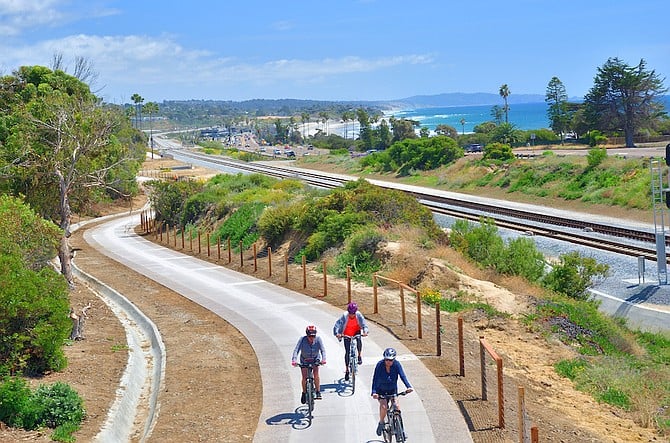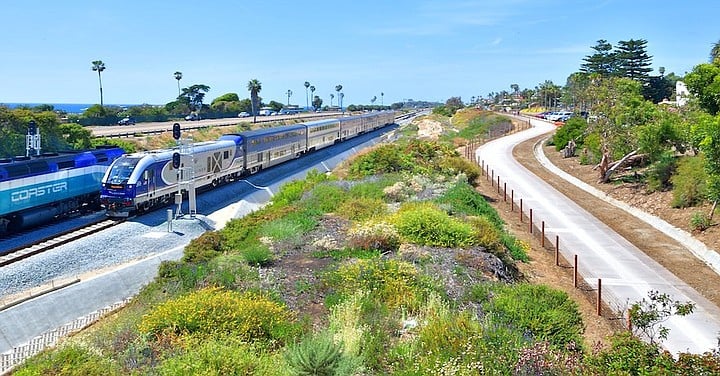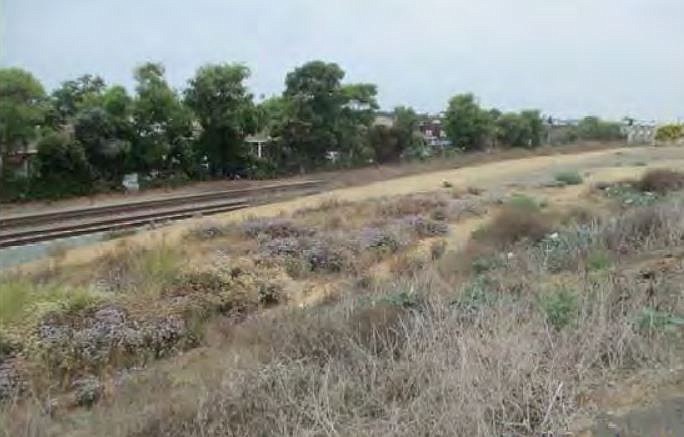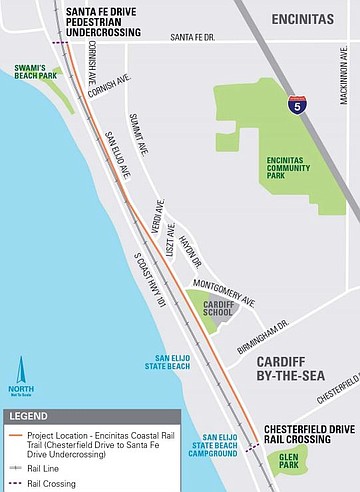 Facebook
Facebook
 X
X
 Instagram
Instagram
 TikTok
TikTok
 Youtube
Youtube

The next segment of the growing Coastal Rail Trail will be built in Encinitas, adding another half-mile to a network planned to yield 44 miles of car-free links from Oceanside to San Diego.

Running along the east side of the rail corridor from Santa Fe Drive to F Street, the multi-use path will connect Cardiff and downtown Encinitas, extending a 1.3 mile stretch that opened in 2019 from Chesterfield Drive to the Santa Fe Drive undercrossing.
In addition to boosting access for biking and walking to and along the coast, the north-south trail will fill a gap in the Cardiff corridor by bringing options to connect with the Encinitas Coaster train and bus station.
Officials expect it to draw crowds. To accommodate the swell of traffic, the trail will be even wider than the first segment.

The San Diego Association of Governments sought approval from the California Coastal Commission last week to begin construction of a 12-foot-wide path with 2-foot shoulders and a 4-foot high post-and-cable fence.
As some see it, highway design has spilled over into trail building, with more signs, pavement and destruction of native plants ruining the natural look of public trails.
"I believe they are too often designed to resemble highways," one comment began, describing overkill of signage and paint markings - "especially highway yellow” - and asking that the proposed two-foot shoulders be reduced to one-foot shoulders to protect more native coastal scrub plants.
Building the trail would result in 0.08 acre of temporary impacts and 0.03 acre of permanent impacts to coastal sage scrub, considered "the fastest disappearing ecosystem" in the state.

The project is part of the North Coast Corridor Public Works Program, which includes highway, rail, biking/walking, environmental, and coastal access improvements. And highway widening is actually what brought about the new trail.
The public works program "specifically calls for a new facility to be constructed to offset impacts associated with widening I-5."
Currently, there's just a narrow dirt walking trail between Santa Fe Drive and F Street. Once it's converted to a Class I multi-use path, it will be considered a new facility, where people can safely walk and bike, fully separated from vehicles and the rail corridor.
In its initial approval of the program, the commission saw that transportation improvements would cause impacts to environmentally sensitive habitats that are inconsistent with multiple policies of the Coastal Act, a staff report says.
But the many regional improvements the program would bring about led the commission to approve the plan; on balance it was seen as most protective of coastal resources.
Sandag proposes to mitigate the impacts to coastal sage scrub off-site by restoring habitat at the Dean mitigation parcel, located along and east of the I-5 right-of-way between Del Mar Heights Road and the San Dieguito Lagoon Bridge.
Back when Encinitas was debating its first segment of the trail - the city wanted it to go on the west, not the east side of the tracks - the proposed 10-foot-wide concrete bike path was criticized for being a “highway” for bicycles.
In the end, an 8-foot path with 2-foot shoulders was built. But the cyclists, scooters, walkers and stroller-pushers kept coming, and officials decided the path was too narrow for safe passing.


The next segment of the growing Coastal Rail Trail will be built in Encinitas, adding another half-mile to a network planned to yield 44 miles of car-free links from Oceanside to San Diego.

Running along the east side of the rail corridor from Santa Fe Drive to F Street, the multi-use path will connect Cardiff and downtown Encinitas, extending a 1.3 mile stretch that opened in 2019 from Chesterfield Drive to the Santa Fe Drive undercrossing.
In addition to boosting access for biking and walking to and along the coast, the north-south trail will fill a gap in the Cardiff corridor by bringing options to connect with the Encinitas Coaster train and bus station.
Officials expect it to draw crowds. To accommodate the swell of traffic, the trail will be even wider than the first segment.

The San Diego Association of Governments sought approval from the California Coastal Commission last week to begin construction of a 12-foot-wide path with 2-foot shoulders and a 4-foot high post-and-cable fence.
As some see it, highway design has spilled over into trail building, with more signs, pavement and destruction of native plants ruining the natural look of public trails.
"I believe they are too often designed to resemble highways," one comment began, describing overkill of signage and paint markings - "especially highway yellow” - and asking that the proposed two-foot shoulders be reduced to one-foot shoulders to protect more native coastal scrub plants.
Building the trail would result in 0.08 acre of temporary impacts and 0.03 acre of permanent impacts to coastal sage scrub, considered "the fastest disappearing ecosystem" in the state.

The project is part of the North Coast Corridor Public Works Program, which includes highway, rail, biking/walking, environmental, and coastal access improvements. And highway widening is actually what brought about the new trail.
The public works program "specifically calls for a new facility to be constructed to offset impacts associated with widening I-5."
Currently, there's just a narrow dirt walking trail between Santa Fe Drive and F Street. Once it's converted to a Class I multi-use path, it will be considered a new facility, where people can safely walk and bike, fully separated from vehicles and the rail corridor.
In its initial approval of the program, the commission saw that transportation improvements would cause impacts to environmentally sensitive habitats that are inconsistent with multiple policies of the Coastal Act, a staff report says.
But the many regional improvements the program would bring about led the commission to approve the plan; on balance it was seen as most protective of coastal resources.
Sandag proposes to mitigate the impacts to coastal sage scrub off-site by restoring habitat at the Dean mitigation parcel, located along and east of the I-5 right-of-way between Del Mar Heights Road and the San Dieguito Lagoon Bridge.
Back when Encinitas was debating its first segment of the trail - the city wanted it to go on the west, not the east side of the tracks - the proposed 10-foot-wide concrete bike path was criticized for being a “highway” for bicycles.
In the end, an 8-foot path with 2-foot shoulders was built. But the cyclists, scooters, walkers and stroller-pushers kept coming, and officials decided the path was too narrow for safe passing.
Comments